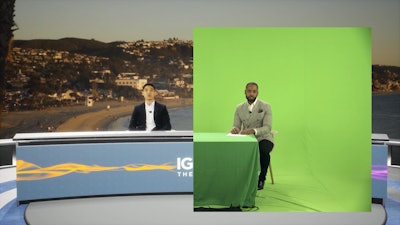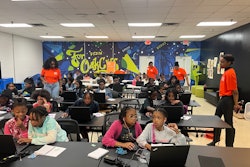
 Photo: Courtesy of Carter Lilley
Photo: Courtesy of Carter Lilley
How he got here: "Artists in professional roles often walk unorthodox paths, and mine is no different. My mother worked as a tech coordinator for our local school system, and from an early age, my brother and I had all the access in the world to fall deeply in love with computers. We loved movies, so we began editing rudimentary videos with footage we filmed in our basement. We loved video games, and so we taught each other how to make them from information we gathered online.
Eventually, I found my first design job as a self-taught motion designer for my university's IT department. On nights and weekends, I would freelance in myriad fields from video editing and graphic design to digital painting. It was these experiences—not my formal schooling—that I carry with me even now as a specialist in events technology and spatial visualization.
BCD is using cutting-edge technology to make our event visualizations as accurate, flexible, and interoperable as possible. We use a mixture of software as well as in-house tools that I have developed. These technologies range from spatial scanning and production-ready environment creation tools all the way to full live-broadcast virtual productions. I have the honor of playing a role in spearheading these technologies here at BCD. But for me, it would not have been possible without the strong framework that came from years of creative curiosity, continual learning and pushing my own skills further."
What innovation means to him: "In my experience, to innovate is simply to remain curious and inquisitive.
I quickly learned that the sentiment 'jack of all trades, master of none,' is false. Being a generalist is a superpower. This philosophy makes it easy to address clients' needs with the best possible innovations available right now. In the ever-shifting landscapes of real-time rendering, virtual production, and space visualization, the innovation is being done for you. It's being done by the wonderful engineering work and increasing availability of consumer technologies. All you need to do is remain curious and willing to adopt these already fantastic solutions."  BCD uses a mixture of software as well as in-house tools that Lilley has developed, including lidar-based photogrammetry to scan ballrooms and event spaces to create a highly detailed and accurate map of the actual environment.Photo: Courtesy of Carter Lilley
BCD uses a mixture of software as well as in-house tools that Lilley has developed, including lidar-based photogrammetry to scan ballrooms and event spaces to create a highly detailed and accurate map of the actual environment.Photo: Courtesy of Carter Lilley "This technology gives us the ability to show the client exactly what they can expect when it comes to their event," explains Lilley. (Pictured: a final rendering.)Photo: Courtesy of Carter Lilley
"This technology gives us the ability to show the client exactly what they can expect when it comes to their event," explains Lilley. (Pictured: a final rendering.)Photo: Courtesy of Carter Lilley Pictured: the finished, in-person stage design!Photo: Courtesy of Carter Lilley
Pictured: the finished, in-person stage design!Photo: Courtesy of Carter Lilley
Memorable moment: "A clear standout moment of my professional career was a project we delivered for a client who needed a cutting-edge hybrid event. Utilizing our expertise in event production and visual design, we created a dynamic virtual environment for our presenters to deliver key messages to their audience. Our final product resulted from the effort of several teams combined with the latest in technology. We custom-built virtual stages from the ground up to meet the client's vision and brought them to life in full 3D using Unreal Engine.
With this virtual stage set, presenters were broadcast and keyed into virtual environments completely live and in real time. This allowed for dynamic camera movements and dynamic intractability. This project was a great opportunity to combine our skill sets into a memorable experience."  "We custom-built virtual stages from the ground up to meet the client's vision and brought them to life in full 3D using Unreal Engine," says Lilley.Photo: Courtesy of Carter Lilley
"We custom-built virtual stages from the ground up to meet the client's vision and brought them to life in full 3D using Unreal Engine," says Lilley.Photo: Courtesy of Carter Lilley
The tech advancements he's excited about right now: "One of the biggest questions clients ask us when it comes to their event is 'What will the room look like?' To help answer that question, we are utilizing lidar-based photogrammetry to scan ballrooms and event spaces to create a highly detailed and accurate map of the actual environment. This technology gives us the ability to show the client exactly what they can expect when it comes to their event. This not only helps with stakeholder buy but it allows clients to try new things.
Utilizing real-time rendering technology like Blender and Unreal Engine, we can then invite the client to a live call and work on their event design virtually—creating a collaborative client experience. The best part is when our call is over, we almost always have an approved design.
On the horizon is a new way of visualizing 3D data called Gaussian Splatting that promises to be the solution to these problems. Referred to as 'splats,' this new method forgoes all traditional means of representing 3D data. What if there were no polygons or textures? What if you could visualize that raw data with infinite accuracy? Splats do just this—all in real time, and recently, even in motion. As the technology matures, it will certainly disrupt many visual development industries. Keep an eye out; maybe in the next few years your favorite films will be using it for VFX!"
What's next: "Professionally, our team is working hard to push our visualization workflow to its limits. As our capabilities grow, we hope to continue developing and using tools that allow clients to see their shows exactly as they will be in person. We are also pushing hard for out-of-the-box ways in which real-time rendering can be used both in show content and previsualization. I am envisioning a (very near) future with live, data-driven graphics and virtual environments.
Personally, I've recently developed a fascination with digital sculpture and have been learning the basics of 3D character workflows. Of all the 3D field I've dabbled in, it may be the most difficult—but also the most rewarding. 3D sculpture is a lot like real sculpture; the artist can work on a piece for days or even months, making slight changes. Stepping back and viewing a finished piece after all that intense focus is extremely rewarding.
The same can be said for all 3D work. It's dense and mired in technical difficulty. But the end result is nothing short of magic. I am extremely fortunate to be in my position. I can honestly say that I love what I do, and that’s in no small part to BCD's dedication to innovation and pursuing new technologies to enhance the event experience."



















